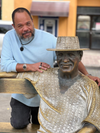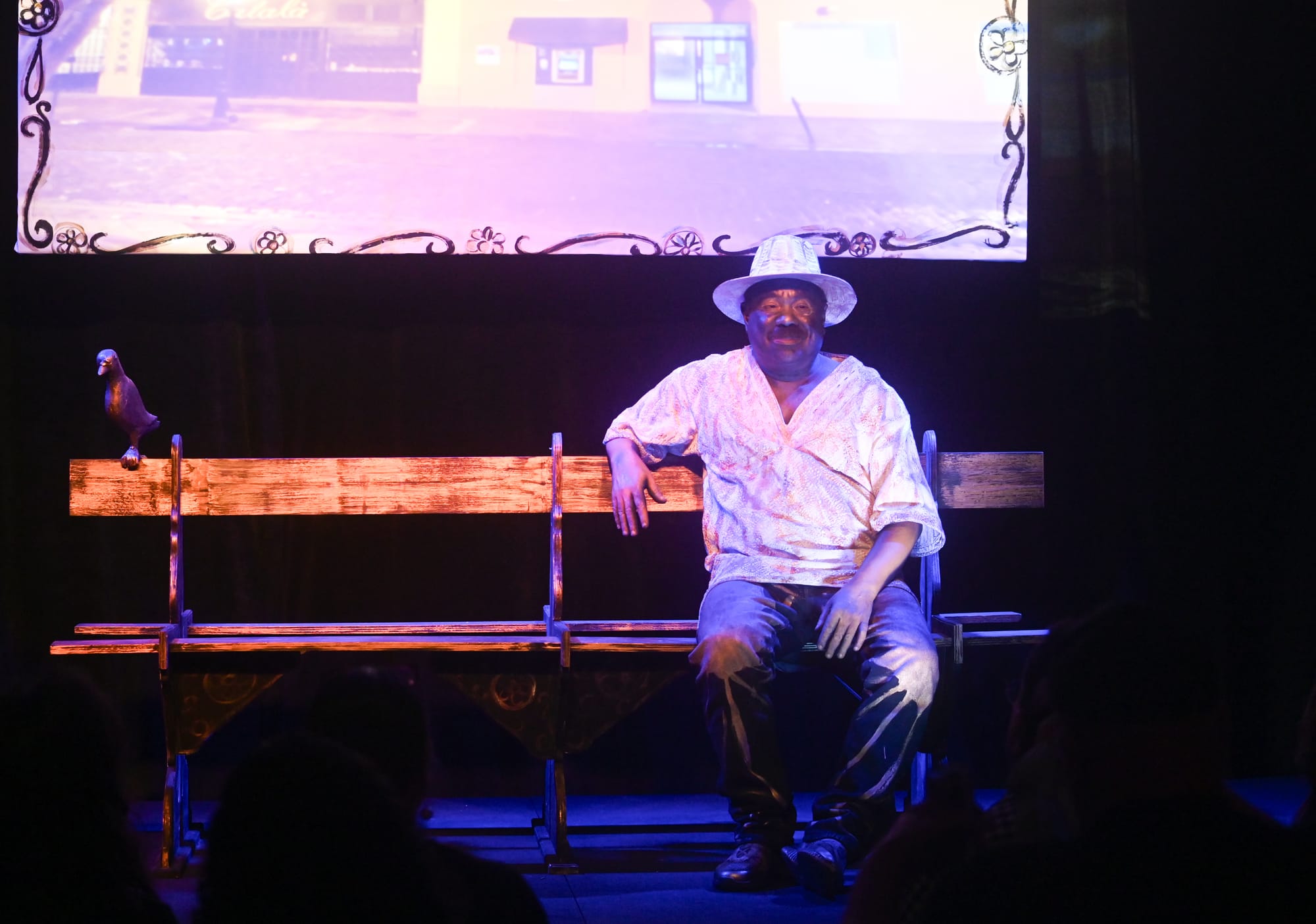Philly’s only 2025 gift guide with spiritual consults, PPA evasion and a Kensington Jason Kelce tee
This year’s holiday gift guide highlights creative, hyperlocal gifts that support Kensington’s artists, makers, and small businesses.
Sunday’s performance concludes BoriCorridor’s 2025 tour, which aims to connect the Puerto Rican diaspora everywhere through the arts.

On Oct. 5, Teatro Esperanza will host the tour finale of BoriCorridor, a national organization dedicated to Puerto Rican artists. The show is an all Spanish-language performance titled “Tite Curet Alonso: Lírica y Poesía,” telling the story of renowned Afro-Puerto Rican composer, Catalino “Tite” Curet Alonso.
If you’ve visited the colonial-era Plaza de Armas in Viejo San Juan, or Old San Juan, in Puerto Rico you’ve likely snapped a picture with a smiling bronze statue seated at the bench. That statue honors Alonso, who wrote songs such as “Las Caras Lindas” made famous by Ismael Rivera and “Periodico de Ayer,” sung by Hector Lavoe.
On Sunday, audiences will be transported to the plaza in Viejo San Juan. Sky blue hues will wash over the stage as Don Alonso’s statue, donning his signature African dashiki, comes to life in the middle of the night.
Portrayed by actor, producer and playwright Josean Ortiz, Alonso begins by narrating his own story to a backdrop of roughly 21 songs. Ortiz gets teary eyed, sharing that he’s come to know Alonso’s family over the years, which has become part of his own.
“Well, one is working with the ancestors,” Ortiz said in a Zoom interview. "That is a strong spiritual bond. As I tell you, my eyes tear up. "
Creating the play wasn’t easy. Although Ortiz has been in the theater business for nearly 45 years, depicting Don Tite is a big responsibility, he says.
"It was a lot of material so I decided instead to use what resonated with me about Tite’s life that aligned with my life, with my experiences as a Puerto Rican man, a Black man, who was poor and raised in a musical environment."
Ortiz pulled details from Alonso’s life partner and folklorist Norma Salazaar’s 400-page biographical book, “Tite Curet Alonso: Lírica y Canción.” In one month and a half he wrote the play. Each performance is tailored to every city he’s performed in. He says the work is ever-evolving, with plenty of material to cut or add.
The composer’s more than 2,000 songs catalogued cultural and social issues such as racism, working- class struggles and poverty while also celebrating romance and Afro-Latine identity. These themes reverberated across Puerto Rico and other Latin American countries.
“His work should not merely be interpreted from a racial lens coming from the U.S., but rather taking into account the local experiences in Puerto Rico and other Latin American and Caribbean countries that he was purposely aiming to talk to,” said Cesar Colón Montijo, an ethnomusicologist and documentary journalist.
“Tite’s songs for me are like a living memory, like a repertoire of the every day.”
An interview in Colón Montijo’s upcoming documentary project on Afro-Puerto Rican singer Ismael “Maelo” Rivera, unveils Alonso’s influence on the singers who came after him.
“He was making them aware of how transcendent they were in terms of representation and identification. He was making them aware of the racial and working class pride. They were inspiring in Santurce, in Puerto Rico, and beyond Puerto Rico,” the scholar added.
Although Alonso’s songs were hits, his music was banned in Puerto Rico for a roughly 15-year- period in a legal battle over royalties. Despite his popularity and contract with Fania Records, he earned little for his musical contributions. For much of his life, he worked as a post office worker, writing songs whenever he could.
Still, his music had permeated the diaspora and beyond in the 1960s and ‘70s. The songs he wrote were propelled by famous Puerto Rican singers and collaborators such as La Lupe, Ismael Rivera, Cheo Feliciano and Tito Puente, as well as Italian singer Tony Croato.
Tasked with honoring 100 years of the composer's impact, Ortiz wanted to drive home the significance of what Don Alonso stood for. Then came the idea of the statue in the town square.
He explained: “At the break of dawn, where there’s nobody around, not one person, he begins to tell his story until sunrise when he returns to his original position."
This play is part of his efforts to preserve facets of Puerto Rico’s cultural legacy and history through theater and music. He is also a resident artist at the Fundación Nacional para la Cultura Popular. Social and political themes underscore much of Ortiz’s work, who is known for plays such as “Frantz Fanon: la voz del alma revolucionaría” and “El Cielo del Maestro Rafael.” A self-described jack of all trades, he works on all elements of theater production — as stage director, producer and actor in many of his own plays — where he brings to the fore key historical figures in Puerto Rican culture.
This piece, however, was special as it was driven by personal experiences.
Like Alonso, Ortiz’s grandfather also grew up in poverty on the island and became a musician. His grandfather, Guillermo Lopez, was a sugarcane worker who became blind from an infection when a piece of burning sugarcane fiber got in his eye. To occupy his time, he began to play his guitar and sing. His musical prowess was recognized in Loiza, particularly by the journalist Rafael Quiñones Vidal whose TV program featured up and coming musicians like his grandfather.
These are the roots of his artistic sensibilities, and why the music resonated so deeply in the first place. When audiences find him after previous shows, he notices they share similar sentiments. The story activates memories and often feelings people in the diaspora may keep bottled up.
Bringing this knowledge is important for younger generations, says Elsa Mosquera, producer of this BoriCorridor tour. When BoriCorridor began 12 years ago, the goal was to give more artists exposure and allow audiences across the U.S. to connect with artists from the island.
“For me it’s been an important mission to do that, for people to understand that our art, music, theater, dance, is at the same level as the rest of the world and plus, we make important contributions. These histories are equally important and we are part of the same humanity.”

Themes of migration, of love and social consciousness are universal, Mosquera said. She advocates for performances that are musical in nature because it lands with audiences in ways a traditional history lesson does not. That became more notable recently because of artist Bad Bunny’s residency in Puerto Rico, which highlighted Bomba and Plena performers harking back to the island’s African and Indigenous ancestors.
The fusion of song and historical narrative have long been a part of Puerto Rican storytelling methods. Some music styles like plena are considered the “people’s newspaper” or the “singing newspaper.” The genre’s narrative lyrics serve as a community periodical, covering current events with social or political themes.
Alonso employed these methods in the songs that he wrote. Before he became known as a composer, Tite Curet Alonso was a postal worker. For 30 years, he sorted and delivered mail to fellow Boricuas. Then, near mid-age, he worked as a journalist.
“His work as a journalist, but also in the post office … allowed him to really listen, collect stories from the streets, from the street corners,” Colón Montijo said. “His chronicle songs, the archetypal characters that he created, spoke to people from different backgrounds. They were lettered, elaborated, complicated in terms of the profoundness of his writing, but also simple, clearly presented.”
The show is rooted not only in Alonso's history, but also Puerto Rico and the varying experiences of the diaspora who left the island. Ortiz says migration informed the contents of Alonso’s music.
“When one talks about the American dream, it’s not until you live outside of Puerto Rico that reality strikes. That absolutely gave his work more validity, and more life, and he dared to discuss, talk about, and report openly on what other composers hadn’t done before. That is what makes it universal."
He added: “It never stops being a history class about Puerto Rico. [Tite] tells his own history from the time he was born, while at the same time it is tied to Puerto Rico’s history."
Tickets are $15, available at this link. The show will take place on Sunday, Oct. 5 at 6 p.m., at Teatro Esperanza, 4261 North 5th St., Philadelphia, PA 19140.
Have any questions, comments, or concerns about this story? Send an email to editors@kensingtonvoice.com. Or call/text the editors desk line at (215) 385-3115.
Stay informed with community-driven reporting, local events, and neighborhood updates — every week, free to your inbox.